Underwater Robot Global Vision Game
Global Vision Game is the first kind of game held in the Underwater Robot Competition.
The current Global Vision Games include 1VS1 water polo, 2VS2 water polo, Relay Race With Ball Under Global Vision, Avoiding Barriers With Ball Under Global Vision, Cycling With Ball Under Global Vision, Ball-passing Relay Under Global Vision, etc.
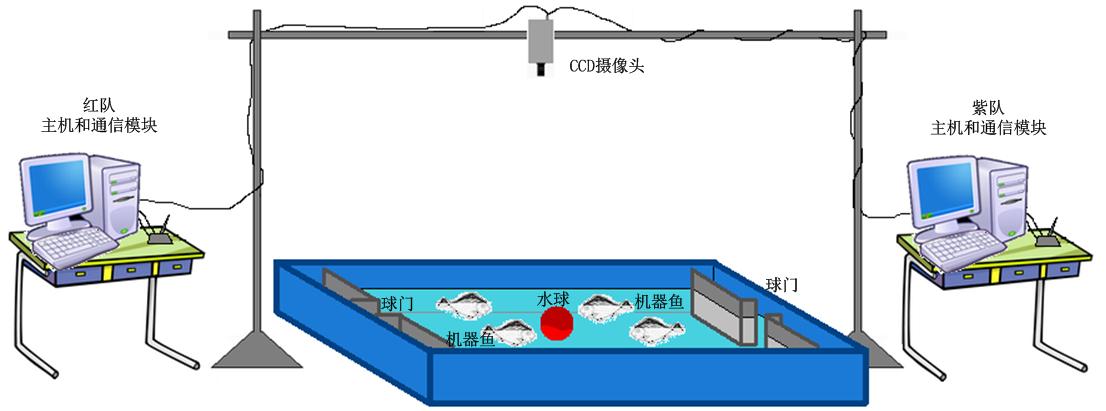
Schematic plot of Global Vision Game
New Game Introduction
一. Relay Race With Ball Under Global Vision
Each team sends two robotic fish to take part in the game. In the initial state, two fish are placed in the center of the wall on each side of the pool as shown in Figure 2-3. When the game starts, the robotic fish A-F1 on side A swims to side B with the ball. After the ball meets the wall of side B, A-F1 stops. Meanwhile A-F2 starts to take the ball back to side A. After the ball meets the wall of side A, A-F2 returns to side B with the ball. After the ball meets the wall of side B, A-F1 restarts to take the ball back to side A. The game is over when the ball meets the wall of side A.
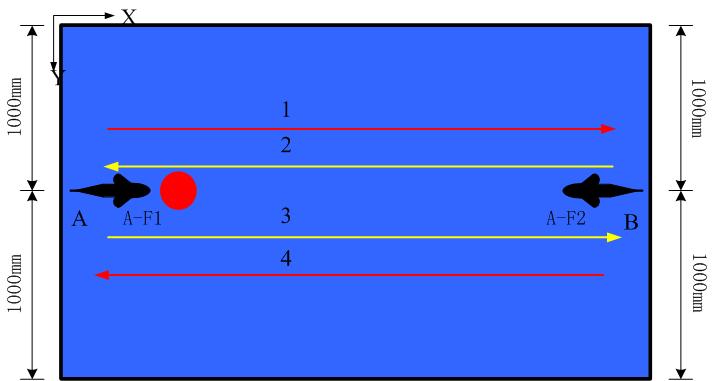
Schematic plot of relay race with ball under global vision
The game should be finished within 8 minutes and only can be played once. No timeout is permitted during the game.
The score is recorded by the referee according to the following rules:
(1) The robotic fish should be static before the game and can only start after the referee blows the whistle. The robotic fish is not permitted to be controlled manually from remote. Once found, the team will be disqualified.
(2) If the team finishes the game within 8 minutes, the used time will be recorded. When the game is finished, both robotic fish should be static automatically. Otherwise 15 seconds will be added. The team ranking will be ordered by the time length. The fastest team is the champion, and so on.
(3) If the team fails to finish the game within 8 minutes, the completed stages will be counted (4 stages in total) as the score. After A-F1 swims with the ball from side A to side B and the ball meets the wall of side B, stage 1 is completed. After A-F2 swims with the ball from side A to side B and the ball meets the wall of side B, stage 2 is completed. After A-F2 swims with the ball from side A to side B and the ball meets the wall of side B, stage 3 is completed. After A-F1 swims with the ball from side B to side A and the ball meets the wall of side A, stage 4 is completed.
(4) If two or more teams complete the same number of stages within 8 minutes, the teams will be ordered by the time used for stage 1 and the team ranking refers to rule (2).
二. Avoiding Barriers With Ball Under Global Vision
Each team sends one robotic fish to take part in the game. In the initial state, the robotic fish and the ball are placed in the center of the wall on each side of the pool, while the barriers are composed of four goals as shown in Figure 2-4. The robotic fish A-F1 starts from the center of the wall on side B, passes the path 1 and path 2 successively and arrives at side A. Then A-F1 passes path 2 and path 1 successively and returns to side B with the ball. The game is over when the ball meets the wall of side B.
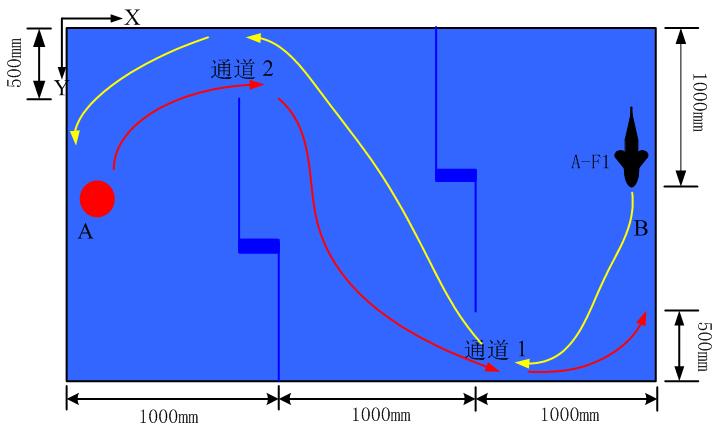
Schematic plot of avoiding barriers with ball under global vision
The game should be finished within 8 minutes and only can be played once. No timeout is permitted during the game.
The score is recorded by the referee according to the following rules: (1) The robotic fish should be static before the game and can only start after the referee blows the whistle. The robotic fish is not permitted to be controlled manually from remote. Once found, the team will be disqualified. (2) If the team finishes the game within 8 minutes, the used time will be recorded. When the game is finished, both robotic fish should be static automatically. Otherwise 15 seconds will be added. The team ranking will be ordered by the time length. The fastest team is the champion, and so on. (3) If the team fails to finish the game within 8 minutes, the completed stages will be counted (4 stages in total) as the score. After A-F1 swims from side B to side A through path 1 and path 2 successively, stage 1 is completed. After A-F1 passes path 2 with the ball, stage 2 is completed. After A-F1 passes path 1 with the ball, stage 3 is completed. After A-F1 arrives at side B with the ball and the ball meets the wall of side B, stage 4 is completed. (4) If two or more teams complete the same number of stages within 8 minutes, the teams will be ordered by the time used for stage 1 and the team ranking refers to rule (2).
三. Cycling With Ball Under Global Vision
Each team sends one robotic fish to take part in the game. In the initial state, the robotic fish and the ball are placed in the center of the wall on side A of the pool, while the barriers are composed of four goals as shown in Figure 2-5. The robotic fish A-F1 starts from the center of the wall on side A, passes the path 1 and arrives at side B. After the ball meets the wall of side B, A-F1 returns to side A through path 2 with the ball. The game is over when the ball meets the wall of side A.
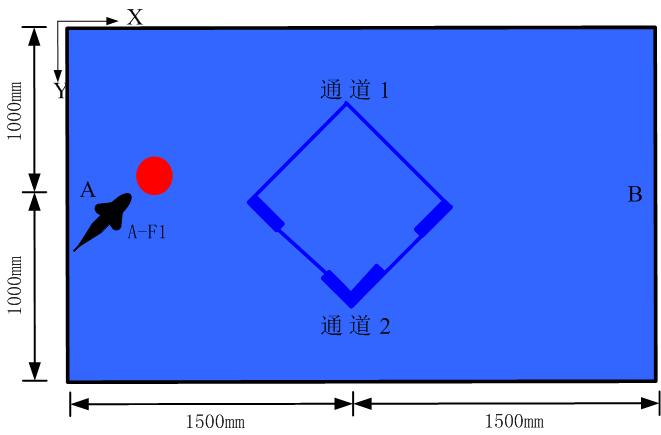
Schematic plot of cycling with ball under global vision
The game should be finished within 8 minutes and only can be played once. No timeout is permitted during the game.
The score is recorded by the referee according to the following rules: (1) The robotic fish should be static before the game and can only start after the referee blows the whistle. The robotic fish is not permitted to be controlled manually from remote. Once found, the team will be disqualified. (2) If the team finishes the game within 8 minutes, the used time will be recorded. When the game is finished, both robotic fish should be static automatically. Otherwise 15 seconds will be added. The team ranking will be ordered by the time length. The fastest team is the champion, and so on. (3) If the team fails to finish the game within 8 minutes, the completed stages will be counted (4 stages in total) as the score. After A-F1 passes path 1 with the ball from side A, stage 1 is completed. After A-F1 arrives at side B with the ball meeting the wall of side B, stage 2 is completed. After A-F1 passes path 2 with the ball from side B, stage 3 is completed. After A-F1 arrives at side A with the ball meeting the wall of side B, stage 4 is completed. (4) If two or more teams complete the same number of stages within 8 minutes, the teams will be ordered by the time used for stage 1 and the team ranking refers to rule (2).
四. Ball-passing Relay Under Global Vision
Each team sends two robotic fish to take part in the game. In the initial state, two robotic fish are placed on the left side of the pool, upside and downside the midline respectively and the ball is placed before the robotic fish A-F1 as shown in Figure 2-6. When the game starts, the robotic fish A-F1 passes the ball to the upside of the pool through path 1 without crossing it. Then A-F2 passes the ball back to the downside of the pool through path 2 without crossing it. Finally, A-F1 heads the ball into the goal and the game is over.
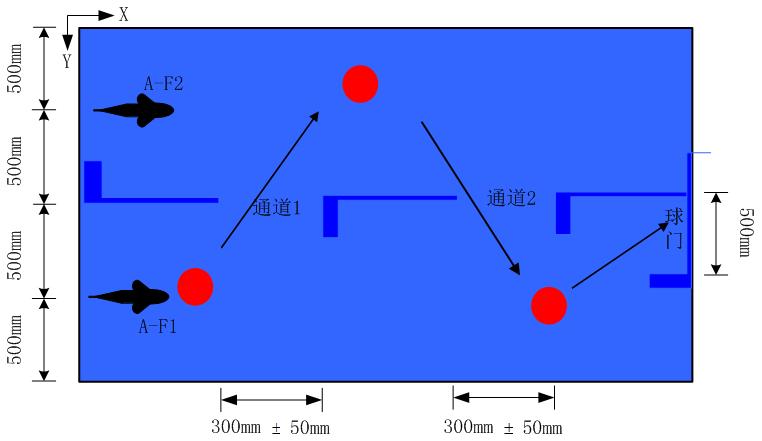
Schematic plot of Ball-passing relay under global vision
The game should be finished within 8 minutes and only can be played once. No timeout is permitted during the game.
The score is recorded by the referee according to the following rules: (1) The robotic fish should be static before the game and can only start after the referee blows the whistle. The robotic fish is not permitted to be controlled manually from remote. Once found, the team will be disqualified. (2) If the team finishes the game within 8 minutes, the used time will be recorded. If A-F1 corsses path 1, 15 seconds will be added. If A-F2 crosses path 2, 15 seconds will be added. When the game is finished, both robotic fish should be static automatically. Otherwise 15 seconds will be added. The team ranking will be ordered by the time length. The fastest team is the champion, and so on. (3) If the team fails to finish the game within 8 minutes, the completed stages will be counted (3 stages in total) as the score. After A-F1 passes the ball to the upside of the pool through path 1, stage 1 is completed. After A-F2 passes the ball to the downside of the pool through path 2, stage 2 is completed. After A-F1 shoots the ball into the goal, stage 3 is completed. (4) If two or more teams complete the same number of stages within 8 minutes, the teams will be ordered by the time used for stage 1 and the team ranking refers to rule (2).
Classic Game Introduction
一.Global Vision Game 1VS1 and 2VS2
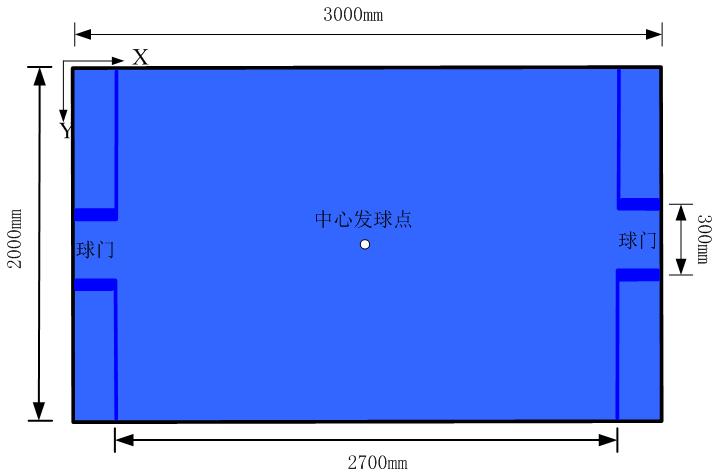
Schematic plot of Global Vision Game
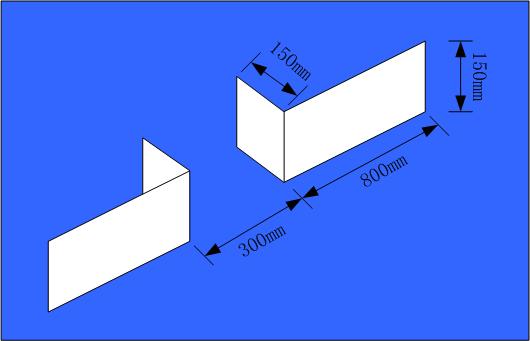
Schematic plot of Global Vision Game
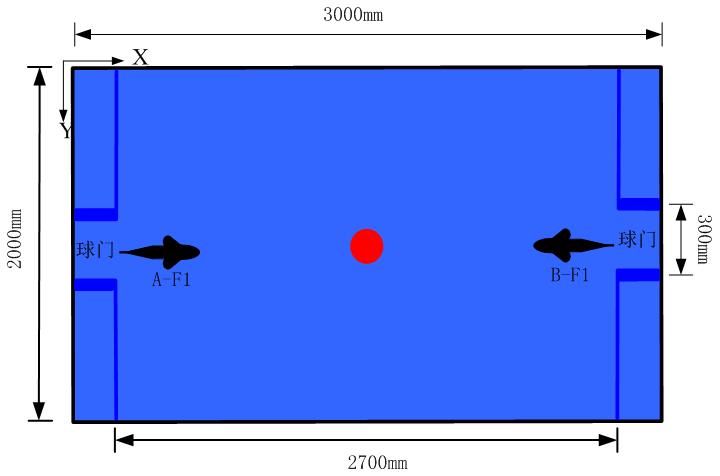
Schematic plot of Kick-off in the 1VS1 water polo game
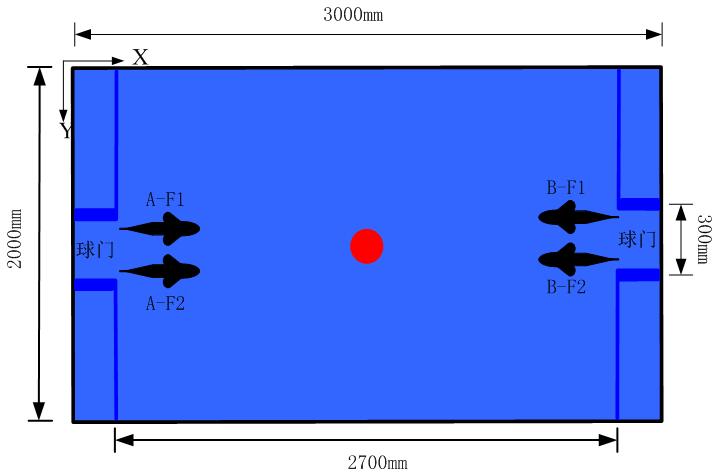
Schematic plot of Kick-off in the 2VS2 water polo game





